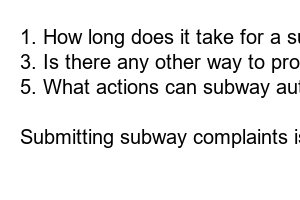지하철 민원 넣는 법
Title: How to Effectively Submit Subway Complaints: A Guide for Frustrated Commuters
Introduction:
As a frequent subway rider, you know that occasional inconveniences or issues can arise during your daily commute. From delays and overcrowded trains to faulty ticket machines and rude staff members, the frustrations can add up. In this blog post, we will provide you with a comprehensive guide on how to submit subway complaints effectively and ensure your voice is heard.
1. Why should you submit a subway complaint?
Submitting a subway complaint is crucial for several reasons. It allows you to share your concerns, provide feedback, and contribute to overall improvements in subway services. Moreover, by speaking up, you can help create a more pleasant and efficient commuting experience for yourself and fellow riders.
2. Where to submit subway complaints?
Subway authorities provide multiple channels for submitting complaints. Whether it’s through their official website, mobile applications, or dedicated complaint hotlines, utilizing these platforms ensures that your complaints reach the right authorities promptly.
3. How to effectively structure your complaint?
When composing your subway complaint, it is important to be clear, concise, and assertive. Provide essential details such as date, time, and location of the incident, along with a detailed description of what happened and how it impacted your commute. Include any supporting evidence, such as pictures or video footage, if available.
4. Key tips for submitting a compelling complaint:
– Begin by expressing your concern or frustration briefly.
– Present any relevant information, such as the train or station involved.
– Describe the incident in clear and objective terms.
– Explain the impact it had on your commute, focusing on inconveniences caused.
– Offer suggestions for improvement, highlighting potential solutions or alternatives.
5. Following up on your complaint:
Once you submit your complaint, it’s crucial to follow up to ensure it receives proper attention. Keep track of any reference numbers or email confirmations you receive upon submission. If you haven’t received a response within a reasonable timeframe, consider escalating your complaint to a higher authority or seeking assistance from commuter advocacy groups.
6. The power of collective action:
Remember that individual complaints are valuable, but collective action amplifies their impact. Encourage fellow commuters to submit their own complaints, highlighting similar concerns. Social media platforms can be a great tool for organizing and spreading awareness, increasing the chances of subway authorities taking notice and addressing the issues at hand.
FAQs:
1. How long does it take for a subway authority to respond to a complaint?
2. Can I submit anonymous subway complaints?
3. Is there any other way to provide feedback aside from formal complaints?
4. How often should I submit a complaint to ensure my voice is heard?
5. What actions can subway authorities take based on my complaint?
6. Are there any alternative methods for resolving subway issues without complaints?
Summary:
Submitting subway complaints is an essential part of advocating for a better commuting experience. By choosing the right channels, structuring your complaint effectively, and following up appropriately, you can increase the likelihood of your concerns being addressed. Remember, collective action is powerful, so encourage fellow commuters to voice their complaints too. Together, we can contribute to improving subway services and ensuring a smoother, more enjoyable journey for all.

